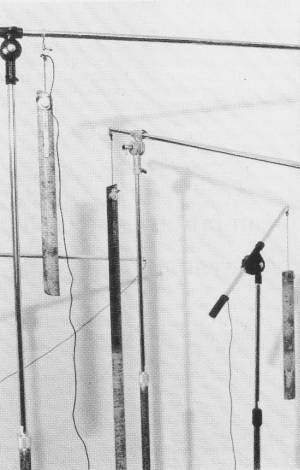Musica Speculativa and sculpture
Joan Brassil
This article first appeared in
NMA8
magazine. In it the author provides some insights into her work with sound
sculpture.
I am a sculptor interested in phenomenology of landscape, that is to say, that which is already there in existence. Within this context, sculptural forms of `found objects' and ephemeral processes are frequently used where `found sounds', as forms in space, may make the sculptural context. The instrumentation of Musica Speculativa has supplemented form, indeed in some cases supplied the form of the sculptural content, within the space of the installation.
Dick Higgins described the Greek Musica Speculativa (from the Latin speculum - mirror) which reflected reality,
"it might or might not be performable but even if it was, its point was in the condition of existence".
In concluding the essay, discussion is engaged from an ecological and environmental perspective.
"Like most beginnings they may be frail. But we are not just modern or post modern today, we are `premillennarian' and it is up to us to determine what that means." [1]
In this transmedia era, with the advantage of electronics, extant inaudible sounds may be transduced and recorded to present or augment `found' sounds. The varied forms of the phenomenological sounds used in my installations over the past five years have all resolved certain spatial connections with ephemeral visual structures.
In
Again in the Sydney Biennale 1986, an installation based in ecology
Consider the Fungi at the Interface
used sound in two horizontal layers, joined by vertical chords, in order to
integrate with the environment of the location.
The location was a large wharf on Sydney Harbour almost underneath the Sydney
Harbour Bridge, the sound scape being the constant lapping of the waters under
the wharf, and the trains above intermittently crossing the bridge - an
extended
double forte
sound - with envelopes of sound contained by the movement of the trains,
varying from whether the crossing was made from the Northern or Southern
approach to the bridge.
The lapping of the waters - a horizontal sound - was augmented and fed into a
sound track of a reflected video of water, whilst in an elevated horizontal,
the bridge trains proceeded in their own time frame of `artistically' random
condition.
To link `microscopic fungi threads' into such a soundscape by a `vertical'
chord is a challenging task. With the aid of a synthesiser, Warren Burt
composed chords from Fibonacci numbers for `natural growth': taking the numbers
between 1 and 21 he made chords which penetrated the space with slowly changing
verticals between the two environmental components. The non melodic series of
chords of slow inner rhythms and slightly varied throbbing, for the `sound of
life', made the connection between two existing sound elements.
Again the expansion of space by the use of sound was made in installations of
Australian landscape of Western Australia and the Central Desert. The sound was
made from the action of wind through telegraph wires. These sounds were
recorded by the placement of piezo-electric transducers on to the wires
themselves for the recording. The results of these sounds of the natural
phenomena are collaged into a continuous composition, giving the form of
landscape where the sounds could have originated, undulating dunes or the
savannah.
The entirely random rhythms as they occur and the separation of tracks by
stereophonic tapes, construct a form and atmosphere as a trans media experience
in the visual arts. The works
Journeys on the Winds of Time
and
Spaces Between
were collated by Alan Lamb of Western Australia. The installation was
exhibited at
Ars Electronica
, Linz Austria 1989. A work currently in process is
Randomly - Now and Then
to be exhibited at the 4th Australian Sculpture Triennial, at ACCA in
Melbourne September 1990.
Here taking the phenomenology of rocks from various subterranean depths,
transducers are affixed to them and power transmitted to the rock's resonant
frequency. The resultant sounds are uniquely resonant according to various
crystalline structures. The timing is regulated by a programme for
`randomness', taking the `on' and`off' times as random numbers of seconds
between 2 and 200, with unpredictable sounds and silences.
In keeping with the current theory of Chaos with nature of unpredictability,
this random sound work operates in an arrangement of minimal structures, as an
instrumental installation relating the connecting of lines of sight and sound,
between the sounding object and the viewer, the constantly changing implied web
of linear connections.
Footnote
1. Dick Higgins
Music from Outside
, Catalogue for the 8th Biennale of Sydney 1990 p130.
back
